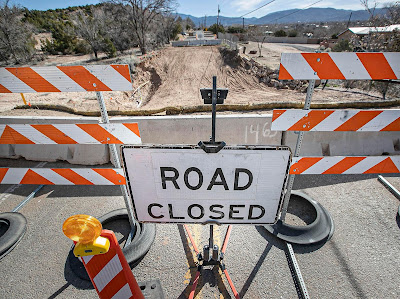Santa Fe River
Recently this spring there was the distressing report that a man had drowned in the Santa Fe river. Snowmelt from a snowy winter came down from the mountains and the river was running, right through town.
It wasn't so much the depth of the water as much as it was the embankments -- they gave way catastrophically as he stood on unstable ground. But the news report said he was washed downstream and had to be pulled from rushing water.
It is hard to picture this calamity though. The Santa Fe river goes right through town and we drive across it all the time. That is, we cross a dry sand bed or at times a narrow stone channel with a tiny stream in it.
Beyond the center of town it looks like this, as volunteers spent a day cleaning trash from a wide scoured section of riverbed. That water is wading depth.
 |
| Clean up volunteers at the Santa Fe River |
But almost all year there is no water at all covering the dry sand.
Of course it wasn't always this way. Until 1940 the river ran all year, draining the mountains in the east and eventually connecting to the Rio Grande 45 miles away to the west. Children fished, old timers remembered cottonwoods and alders lining the banks, and farmers irrigated crops through an extensive ditch system of acequias that diverted river water reliably all summer.
,_Santa_Fe_in_2022.jpg) |
| Water gate at the original Acequia Madre (mother ditch) |
Long ago ancient people built three major villages at the natural springs that bubbled up along the course of the river. Santa Fe sits where those ancient villages were. They were all abandoned in the mid 1300s, long before the Spanish came, and no one is sure why or where they went.
As Santa Fe grew in the 1900s, two dams were created upstream to provide the city with water. Later a system of wells were dug, and even later a connection to Rio Grande water was installed. There's enough water for the small city we are, but the river no longer runs and the springs are gone.
Except at times. In spring there is water, enough to cause havoc.
Earlier this year the river washed out culverts in a section of West Alameda street -- a major thoroughfare. The road has been closed and repairs won't be finished until August.
 |
| Culverts collapsed on West Alameda St. |
This is no side road, it's an artery leading into and out of town and closing it for months has been a problem.
It's so hard to imagine the thin dribble of the Santa Fe river as it is now -- dammed, diverted and diminished -- as a rushing waterway causing road washouts and a tragic drowning. It's hard to imagine the life giving flow that ran all year, supported trees and wildlife and watered villages and farms.
I would have liked to see it that way.

Comments